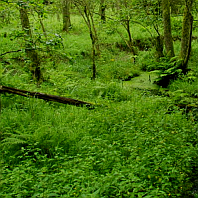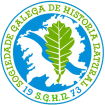As Mariñas biodiversity
The outstanding landscape and nature of the A Coruña locality of As Mariñas (Galicia, Spain) is little known by locals and visitors and, to a certain extent, by academics. A comprehensive list of the existing species would be very extensive and tedious. Here we describe some of the most notable features.
The habitat par excellence is the riparian forest. It is usually located in narrow river valleys here, and it is classified as priority habitat by the European Union, under the name of “alluvial forests of Alnus glutinosa and Fraxinus excelsior”, making reference to the two dominant species, alder and ash.
Other characteristic vegetal formations in this region are reed beds, located in the marshes of river estuaries. The nearby reed beds of Phragmites australis are scarce, so they should be preserved. Finally, the deciduous forest, dominated by the pedunculate oak
(Quercus robur) and followed by a huge variety of tree species, covers most of the natural biotopes.
The region is rich in fern species, several of which are protected. Isoetes fluitans is an endangered species found in the proximity of the River Mandeo, and possibly in some of its headstreams too.
Dryopteris aemula, Dryopteris guanchica, Hymenophyllum tunbrigense and Trichomanes speciosum meet in this area; they are categorized as vulnerable species and can be found in fluvial groves at low altitude. On the other hand, there are five populations known of Woodwardia radicans, two of them at sea level, included in Annex II of the Habitats Directive.
The local flora is insufficiently studied, despite offering opportunities to verify the protected species’ new locations. The dense human population on the coast has led to the greatest species diversity being found in remote riparian forests and in the meadows of the River Mandeo high basin. Thus, we can find the endemic narcissus of the Galician-Portuguese area, Narcissus cyclamineus, catalogued as vulnerable, whose population size is yet to be determined in our locality.
Atlantic salmon (Salmo salar) tops the list of migratory fish classified as vulnerable by environmental legislation, followed by the sea lamprey (Petromyzon marinus) and the European eel (Anguilla anguilla).
The Atlantic salmon population present in the River Mandeo, together with those in other Galician rivers, forms the southernmost population of their worldwide distribution. There is also European eel in the River Mero, being specifically protected by European legislation because of its delicate state of conservation. Finally, bermejuela (Achondrostoma arcasii), in this area limited to the River Mandeo, is an endemic species of the Iberian Peninsula which requires special attention due to the uniqueness of its habitat.
Among the invertebrate group, the most endangered species of the aquatic ecosystems is freshwater pearl mussel (Margaritifera margaritifera). This species is not only protected by the Galician regulations, but also included in annexes II, IV and V of the Habitats Directive. Its last remaining stable and breeding populations are right here, in the River Mandeo and in some other rivers of Galicia. On the contrary, the number of individuals found in the rivers Lambre, Mero and Barcés is small and none was found in the River Mendo. In its larval stage, freshwater pearl mussel implants in the gills of salmonids (salmon, sea trout and trout), so the viability of the species depends entirely on the conservation of these fish.
Carabus galicianus is the name of a nocturnal endemic beetle of the Iberian Northwest. It is easily identifiable by the striking red colour of the first segment of its legs, which contrasts with the dark body. It is usually found in the shady and moist deciduous forest linked to clean and fast-flowing waters, where it feeds mostly on larvae and aquatic molluscs. This region’s riverbanks are a favourable habitat, being a good indicator of the water quality. It is listed as vulnerable by the IUCN.
Another insect linked to the fluvial environment is the dragonfly Oxygastra curtisii, where they patrol the sections of river containing many pools with sunny shores which form its territory. It is an endangered species, so it is included in annexes II and IV of the Habitats Directive. It has been cited as being present in the River Mandeo.
The osprey (Pandion haliaetus) is the most spectacular bird of prey among those usually seen in this area. Furthermore, a great variety of forest and open land birds of prey are also found here.
The Betanzos estuary is home to one of the biggest populations of the water rail (Rallus aquaticus) in Galicia. Although hardly observable because it hides in the reed beds, it is easily detectable thanks to its pig-like squeal. There are numerous other aquatic species, such as the common greenshank (Tringa nebularia), which uses the estuary as a passage and wintering place during migrations.
There are other birds which are scarce, although very interesting. Among them the reed bunting subspecies lusitanica (Emberiza schoeniclus lusitanica), which lives only in the west of the Iberian Peninsula and whose estimated Spanish population is around 70 pairs, has been seen during the nesting period in the Betanzos estuary.
The otter (Lutra lutra) is the king of the River Mandeo. However, it is more easily seen in the wide spaces of the Betanzos estuary or in the Cecebre reservoir, where even family groups can be seen. Much more difficult to locate, but also widely distributed along this river and protected at national level, is the Pyrenean desman (Galemys pyrenaicus). Both are included in Annex II of the Habitats Directive.
The nocturnal nature of the badger (Meles meles) would make its presence undetectable were it not for the conspicuous signals in the form of fingerprints, rooting around, and latrines. It is abundant in the surroundings of the estuary, where it takes advantage of a diversity of habitats and the ecotones formed between them, where it mainly looks for earthworms.
In the clean streams, among the roots of trees or beneath stones, the gold-striped salamander (Chioglossa lusitanica). Easily identifiable by its long tail and the two copper-coloured stripes that run along its body, this beautiful endemic species of the Northwest Peninsula has the bulk of its population in Galicia.
The Iberian frog (Rana iberica) is an endemic species of the West of the Iberian Peninsula. It is found among the grass close to streams; some sub-adults roam through the leaves of the deciduous forest, where their brown colour makes them go unnoticed. Like the gold-striped salamander, it is classified as a vulnerable species.
The thermal inversion in the steep river valleys of the region, where low-lying areas have more moisture and less sunlight than high zones, favours the presence of the Iberian rock lizard (Iberolacerta monticola). These populations at low altitudes are unusual compared to its usual distribution, more in the mountains, thus they are protected by Galician law.
We can find other lacertids, such as the ocellated lizard (Timon lepidus), already at the northern limit of its usual distribution, being characteristic of more Mediterranean environments, or the Iberian emerald lizard (Lacerta schreiberi), which prefers more humid habitats with shrub vegetation. There is also Iberian cross adder (Vipera seoanei), although it is not easy to inadvertently stumble upon it.
Sources
Virtual Encyclopaedia of Spanish Vertebrate: Portal of the Association of Friends of the Natural Science National Museum, with on-line information on the natural history of Spanish vertebrates. It gives information about distribution, habitat, conservation, ecology, etc. for each species, with the possibility of downloading material in PDF format.
National Biodiversity Inventory: On this website you can find the Atlas and Red Books of Spanish fauna and flora, as a result of the project developed by the Ministry of Agriculture, Food and Environment. It is possible to download them in PDF format, either in its entirety or just the species’ specific factsheet.
BIGA: The website of the Biodiversity Galician Association (BIGA) shows an extensive photographic gallery of plants. Moreover, it allows downloading of their bulletins and some articles in PDF format.
Galician Biodiversity: The web page dealing with biodiversity on the website of the Nature Conservation Office of the Xunta de Galicia offers diverse information, including descriptive sheets on many of the threatened species (they can be downloaded in PDF format).



















